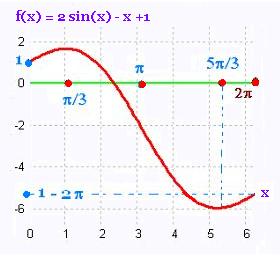Calculus I: Trigonometric functions
Derivative
1. Derivative of trigonometric functions
1.1. Definitions
1.
d(sin x)/dx = cos x
d(sin x)/dx =
lim (sin(x + Δx) - sin x)/Δx
Δx → 0
We have:
sin(x + Δx) = sin x cos Δx + cos x sin Δx
sin(x + Δx) - sin x =
sin x (cos Δx - 1) + cos x sin Δx
Therefore
d(sin x)dx =
lim (sin x (cos Δx - 1) + cos x sin Δx)/Δx
Δx → 0
=
lim (sin x (cos Δx - 1))/Δx
+ lim (cos x sin Δx)/Δx
Δx → 0
=
(sin x ) lim (cos Δx - 1))/Δx
+ (cos x) lim sin Δx)/Δx
Δx → 0
=
(sin x ) (0) + (cos x ) (1) = cos x
Δx → 0
Hence:
d(sin x)/dx = cos x
d(cos x)/dx = - sin x
Proof: see exercises section.
2.
d sin (f(x))/dx
Let y = sin u with
u = f(x)
The derivative chain rule is written as:
dy/dx = (dy/du)(du/dx)
That is:
dy/dx = (d (sin u)/du)(f'(x))
= cos u . f'(x) = (cos f(x)) . sin (f(x))/dx
Hence:
d sin (f(x))/dx = (cos f(x)) . d(f(x))/dx
3.
We have also:
d cos (f(x))/dx = - (sinf(x)) . d(f(x))/dx = - f'(x) . sin f(x)
d sin (f(x))/dx = f'(x) . cos f(x)
d cos (f(x))/dx = - f'(x) . sin f(x)
1.2. Examples
a)
d sin (3 x + 1)/dx = d sin (f(x))/dx =
(cos (3 x + 1)) . (3 x + 1)' =
(cos (3 x + 1)) . (3) = 3 cos (3 x + 1)
b)
cos2y = 2y + sinx
2 (cos y) (- sin y) (dy/dx) = 2(dy/dx) + cos x
- 2 sin y cos y (dy/dx) = 2(dy/dx) + cos x
- 2 (dy/dx) (sin y cos y + 1) = cos x
2 (dy/dx) (sin y cos y + 1) = - cos x /2(sin y cos y + 1) =
- cos x /(sin (2y) + 2)
2. Example of trigonometric function

Let f(x) = 2 sin x - x + 1
a)
Domaine is D = R.
We study this function in the interval I = [0, 2π]
b)
f'(x) = 2 cos x - 1
f'(x) = 0
cos x = 1/2
The critic numbers are {π/3, 5π/3}
f '(x) > 0 → cos x > 1/2
→ - π/3 < x <π/3 → (x <π/3 and
x > 5π/3)
so in the interval ]0,π/3[ ∪ ]5π/3, 3π[,
the function increases.
c)
f''(x) = - 2 sin x
f''(x) = 0
sin x = 0
The transition numbers are {0, π, 2π}
They are inflection points.
d) Since the interval of the study of the
function is [0, 2π], the horizontal and
oblique asymptotes are not considered. In addition,
the function is not discontinuous at any point in
I (and R), so the verical asymptote are not considered.
3. Inverse trigonometric function: Derivative
Let f a function and g is its inverse. We have the following formula:
f(g(x)) = x, and
(df(g)/dg) . g'(x) = 1
3.1. Derivative of ArcSin(x)
Let:
y = g(x) = arcsin x
defined by
x = sin y and
- π/2 <= y <= +π/2
f(g(x)) = sin [ArcSin(x)]
(d sin y/ dy ) . (d Arcsin x /dx) = dx/dx = 1
(cos y) . d Arcsin x)/dx = 1
d(Arcsin x)/dx = 1 /cos y = 1/(1 - sin2y)1/2 = 1/(1 - x2)1/2
d(arcsin x)/dx = 1/(1 - x2)1/2
3.2. Derivative of ArcCos(x)
Let:
y = arccos x
defined by
x = cos y and
0 <= y <= +π
1 = dx/dx = d(cos y)/dy . dy/dx =
(- sin y) . d(arccos x)/dx
Therefore:
d(arccos x)/dx = - 1/sin y =
- 1/(1 - cos2y)1/2 = - 1/(1 - x2)1/2
d(arccos x)/dx = 1/(1 - x2)1/2
3.3. Derivative of ArcTan(x)
Let:
y = arctan x
defined by
x = tan y and
- π/2 < y < +π/2
1 = dx/dx = d(tan y)/dy . dy/dx =
(1/cos2(y)) . d(arctan x)/dx
Therefore:
d(arctan x)/dx = cos2(y) =
= 1/(1 + tan2y) = 1/(1 + x2)
d(arctan x)/dx = 1/(1 + x2)
3.4. Derivative of ArcCot(x)
Let:
y = arccot
defined by
x = cot y and
0 < y < +π
1 = dx/dx = d(cot y)/dy . dy/dx =
- (1 + cot2 y) . d(arccot x)/dx
Therefore:
d(arccot x)/dx = - 1/(1 + cot2y) = - 1/(1 + x2)
d(arccot x)/dx = - 1/(1 + x2)
3.5. Derivative of arcsin (f(x))
Let:
y = arcsin u
with u = f(x)
The chain rule derivative is written as:
dy/dx = dy/du . du/dx
1/(1 - u2)1/2 . df(x)/dx =
1/(1 - f(x)2)1/2 . df(x)/dx
d[arcsin f(x)]/dx = 1/[1 - f(x)2]1/2 . df(x)/dx
Similarly, we have:
d[arcos f(x)/dx = - 1/[1 - f(x)2]1/2 . df(x)/dx
d([arctan f(x)/dx = 1/[1 + f(x)2]1/2 . df(x)/dx
d[arcot f(x)/dx = - 1/[1 + f(x)2]1/2 . df(x)/dx
3.6. Other trigonometric function: Derivative
3.6.1. sec(x) and arcsec(x)
By definition:
sec(x) = 1/cos(x)
d sec(x)/dx = sin(x)/cos2(x)
d csc(x) /dx = - cos (x) /sin2(x)
Let:
arcsec(x) = y
sec(y) = x
1 = dx/dx = d(sec(y))/dy . dy/dx
dy/dx = 1/d(sec(y))/dy
= 1/sin(y)/cos2(y) = cos2(y)/sin(y)
= (1/sec2(y)) . 1/[1 - cos2(y)]1/2
(1/xsup>2) . 1/[1 - (1/sec)2(y)]1/2 =
(1/xsup>2) . 1/[1 - (1/x)2]1/2 =
1/x [x2 - 1]1/2
Therefore:
d(arcsec(x))/dx = 1/x(x2 - 1)1/2
d(arcsec(x))/dx = 1/x(x2 - 1)1/2
d[arcsec(f(x))]/dx = 1/f(x)[f(x)2 - 1]1/2 . df(x)/dx
3.6.2. csc(x) and arccsc(x)
By definition:
csc(x) = 1/sin(x)
d(arccsc(x))/dx = - 1/x(x2 - 1)1/2
d[arccsc(f(x))]/dx = - 1/f(x)[f(x)2 - 1]1/2 . df(x)/dx
4. Exercises
a)
f(x) = cos x
we want to prove that d(cosx)/dx = - sin x.
b)
f(x) = cos ( 3 x2 + 1)
Determine df(x)/dx.
|

